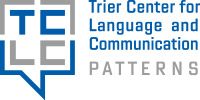Click here to get to the OMP-system.
Call for chapter proposals for an edited volume “Pattern Theory in Language and Communication”
Pattern Theory in Language and Communication
Call for chapter proposals for an edited volume
Editors: Sabine Arndt-Lappe, Milena Belosevic, Peter Maurer, Claudine Moulin, Achim Rettinger and Sören Stumpf
[PDF]
The volume Pattern Theory in Language and Communication will provide a state-of-the-art overview of interdisciplinary perspectives on the nature of patterns in language and communication. In contrast to the terms that come with underlying assumptions about which forces produce pertinent patterns or focus on phenomena that cut across and are, therefore, not compatible with established categories (e.g. ‘rules’, ‘schemata’, ‘frames’, ‘topics ‘, ‘style‘), we define ‘pattern’ as empirical surface phenomena that are identified by researchers in language usage and communication. Putting ‘pattern’ at centre stage, we focus on a strictly empirical, data-driven, and, hence, methodological perspective. The central aim of this book, then, is to lay out and discuss the empirical foundations of research on patterns in language and communication. The volume seeks to bring together different linguistic disciplines and communication and media studies (cf. below for further details).
Organisation
We will adopt an innovative publication format. The book will be published as an Open Access volume with an internationally visible, high-quality publisher. We are envisaging doing the publication with Heidelberg University Publishing (https://heiup.uni-heidelberg.de/), a genuine open-access publisher, who have already expressed an interest in the project. Each contribution will be peer-reviewed by at least one external and one internal reviewer. At least one review will represent a perspective from a different research community. Reviews will be double-blind in the first round. Upon acceptance of the contribution, however, reviewers will be invited to publish a short commentary on the basis of their review, which will be published together with the article under their name. This way, we hope that both the process of making the book as well as the book itself will foster dialogue among participating researchers and research communities.
We invite contributions that address the following key empirical properties of patterns in language and communication:
-
Patterns are detected by inductive means (Section 1. Ontologies and formal descriptions of patterns). This section is about abstract formalisms that are underlying patterns. When describing patterns, certain assumptions have to be made about a) what are atomic building blocks of patterns and b) how is the space of possible interdependencies between such atomic units defined. On this level of abstraction, such pattern formalisms are not restricted to a single level of description (see Section 2) but can be universally applied. The basic questions that we ask in this section are: What are underlying ontologies or formal descriptions of patterns? To what levels of description are these ontologies applied? What is the role of preconceived notions of categories and inductive biases, which researchers apply to the data in order to detect patterns?
-
Patterns are assigned to different levels of description (Section 2. Types and structural properties of patterns). In this section, we welcome contributions on both formal (e.g., at sound, word, multi-word, sentence, text level) and meaning (e.g., semantic frames, topics) patterns as well as multimodal and cross-modal patterns (e.g., between text and vision/image, language and gestures, text and speech). We also welcome contributions that deal with patterns at the crossroads of different levels of description (e.g., patterns between morphology and syntax or between lexicon and onomasticon). The guiding question for contributions is: Which methods are applied to extract and analyse patterns on specific levels of description? Contributions should present case studies, and the focus should be on the discussion of methodologies (e.g., quantitative and qualitative corpus studies, experimental approaches).
-
Patterns also emerge in communicative constellations among actors and with respect to the dissemination, reception, and effects of communication (Section 3. Patterns in communication networks and communication effects). This section explores these patterns from the perspective of communicators and receivers of messages. It is concerned with the networks and contexts in which ideas are spread and how they influence – or fail to influence – (different) publics. Concepts and questions covered in this section are, for example, discourse coalitions, expert networks, filter bubbles, agenda-setting processes, and (political) mobilisation in networks and movements. Regarding effects, the focus includes patterns such as framing effects, effects on knowledge, trust, and social behaviour.
-
Patterns are inherently dynamic, i.e., they are prone to change or evolve diachronically or through contact with other languages or discourses (Section 4: Pattern dynamics). We invite contributions focusing on patterns and language change, historical text patterns, analogy, historical formulaic language, the dynamic of patterns in communication, pattern formalism, patterns in contact between different languages or language varieties as well as patterns in translation studies. Contributors are invited to answer the following questions: How do patterns in language and communication emerge and evolve across time, in different languages, language varieties, and discourses? How can pattern formalism also describe the change of patterns over time?
-
Patterns are usually interesting to researchers because they provide evidence for underlying mechanisms producing these patterns, e. g. cognitive mechanisms (Section 5: Patterns – evidence for underlying mechanisms). This section looks at how surface patterns are attributed to causal mechanisms in different theories or approaches. We welcome contributions discussing the link between the evidence (surface patterns) and the assumed mechanism such as cognitive schemas theories (e. g. Construction Grammar, psycholinguistic theories), cognitive frames theory (e. g. in communication theory), the individual approaches (e.g., Forensic Linguistics, studies of literary authorship).


